Related Research Articles

Kazimir Severinovich Malevich was a Russian avant-garde artist and art theorist, whose pioneering work and writing had a profound influence on the development of non-objective art in the 20th century. Born in Kyiv to an ethnic Polish family, his concept of Suprematism sought to develop a form of expression that moved as far as possible from the world of natural forms (objectivity) and subject matter in order to access "the supremacy of pure feeling" and spirituality. Malevich is considered to be part of the Ukrainian avant-garde that was shaped by Ukrainian-born artists who worked first in Ukraine and later over a geographical span between Europe and America.
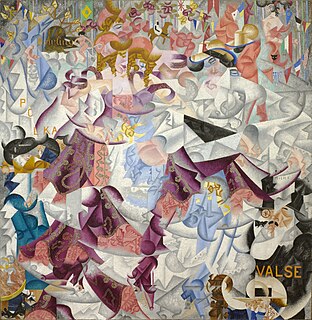
Futurism was an artistic and social movement that originated in Italy in the early 20th century and also developed in Russia. It emphasized dynamism, speed, technology, youth, violence, and objects such as the car, the airplane, and the industrial city. Its key figures included the Italians Filippo Tommaso Marinetti, Umberto Boccioni, Carlo Carrà, Fortunato Depero, Gino Severini, Giacomo Balla, and Luigi Russolo. Italian Futurism glorified modernity and aimed to liberate Italy from the weight of its past. Important Futurist works included Marinetti's 1909 Manifesto of Futurism, Boccioni's 1913 sculpture Unique Forms of Continuity in Space, Balla's 1913-1914 painting Abstract Speed + Sound, and Russolo's The Art of Noises (1913).
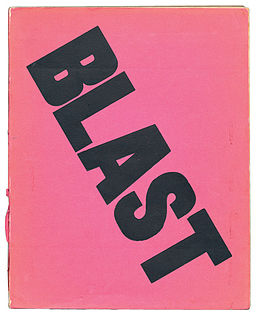
Blast was the short-lived literary magazine of the Vorticist movement in Britain. Two editions were published: the first on 2 July 1914 and featured a bright pink cover, referred to by Ezra Pound as the "great MAGENTA cover'd opusculus"; and the second a year later on 15 July 1915. Both editions were written primarily by Wyndham Lewis. The magazine is emblematic of the modern art movement in England, and recognised as a seminal text of pre-war 20th-century modernism. The magazine originally cost 2/6.

The Russian avant-garde was a large, influential wave of avant-garde modern art that flourished in the Russian Empire and the Soviet Union, approximately from 1890 to 1930—although some have placed its beginning as early as 1850 and its end as late as 1960. The term covers many separate, but inextricably related, art movements that flourished at the time; including Suprematism, Constructivism, Russian Futurism, Cubo-Futurism, Zaum and Neo-primitivism. Many of the artists who were born, grew up or were active in what is now Belarus and Ukraine, are also classified in the Ukrainian avant-garde.

Natalia Sergeevna Goncharova was a Russian avant-garde artist, painter, costume designer, writer, illustrator, and set designer. Goncharova's lifelong partner was fellow Russian avant-garde artist Mikhail Larionov. She was a founding member of both the Jack of Diamonds (1909–1911), Moscow's first radical independent exhibiting group, the more radical Donkey's Tail (1912–1913), and with Larionov invented Rayonism (1912–1914). She was also a member of the German-based art movement Der Blaue Reiter. Born in Russia, she moved to Paris in 1921 and lived there until her death.

Cubo-Futurism was an art movement that arose in early 20th century Russia, defined by its amalgamation of the artistic elements found in Italian Futurism and French Analytical Cubism. Cubo-Futurism was the main school of painting and sculpture practiced by the Russian Futurists. In 1913, the term ‘Cubo-Futurism’ first came to describe works from members of the poetry group ‘Hylaeans,’ as they moved away from poetic Symbolism towards Futurism and zaum, the experimental “visual and sound poetry of Kruchenykh and Khlebninkov”. Later in the same year the concept and style of ‘Cubo-Futurism’ became synonymous with the works of artists within Russian post-revolutionary avant-garde circles as they interrogated non-representational art through the fragmentation and displacement of traditional forms, lines, viewpoints, colours, and textures within their pieces. The impact of Cubo-Futurism was then felt within performance art societies, with Cubo-Futurist painters and poets collaborating on theatre, cinema, and ballet pieces that aimed to break theatre conventions through the use of nonsensical zaum poetry, emphasis on improvisation, and the encouragement of audience participation.

Nina Henrichovna Genke or Nina Henrichovna Genke-Meller, or Nina Henrichovna Henke-Meller was a Ukrainian-Russian avant-garde artist,, designer, graphic artist and scenographer.

Vadym Meller or Vadim Meller, was a Ukrainian-Russian Soviet painter, avant-garde Cubist, Constructivist and Expressionist artist, theatrical designer, book illustrator, and architect. In 1925 he was awarded a gold medal for the scenic design of the Berezil' theater in the Exposition Internationale des Arts Décoratifs et Industriels Modernes in Paris.

David Davidovich Burliuk was a Russian-language poet, artist, publicist and book illustrator associated with the Futurist and Neo-Primitivist movements. Burliuk is often described as "the father of Russian Futurism".
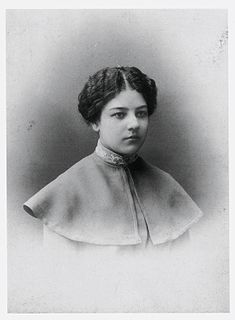
Olga Vladimirovna Rozanova was a Russian avant-garde artist painting in the styles of Suprematism, Neo-Primitivism, and Cubo-Futurism.

Alexander Bogomazov or Oleksandr Bohomazov was a Ukrainian painter in the Russian Empire and USSR, known artist and modern art theoretician of the Russian Avant-garde. In 1914, Alexander wrote his treatise The Art of Painting and the Elements. In it he analyzed the interaction between Object, Artist, Picture, and Spectator and sets the theoretical foundation of modern art. During his artistic life Alexander Bogomazov mastered several art styles. The most known are Cubo-Futurism (1913–1917) and Spectralism (1920–1930).
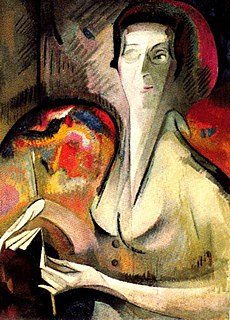
Alice Bailly was a Swiss avant-garde painter, known for her interpretations on cubism, fauvism, futurism, her wool paintings, and her participation in the Dada movement. In 1906, Bailly had settled in Paris where she befriended Juan Gris, Francis Picabia, and Marie Laurencin, avant-garde modernist painters who influenced her works and her later life.

Russian Futurism is the broad term for a movement of Russian poets and artists who adopted the principles of Filippo Marinetti's "Manifesto of Futurism," which espoused the rejection of the past, and a celebration of speed, machinery, violence, youth, industry, destruction of academies, museums, and urbanism; it also advocated the modernization and cultural rejuvenation.
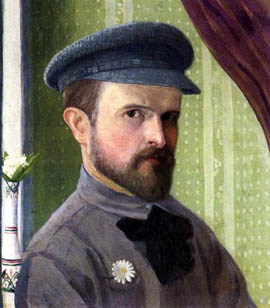
Ivan Vasilievich Kliun, or Klyun, born Klyunkov was a Russian Avant-Garde painter, sculptor and art theorist, associated with the Suprematist movement.

Universal War is an artist's book by Aleksei Kruchenykh published in Petrograd at the beginning of 1916. Despite being produced in an edition of 100 of which only 12 are known to survive, the book has become one of the most famous examples of Russian Futurist book production, and is considered a seminal example of avant-garde art from the beginning of the twentieth century.
Joseph Moisevich Chaikov was a Russian Imperial and Soviet Russian sculptor, graphic designer and teacher of Ukrainian Jewish descent.
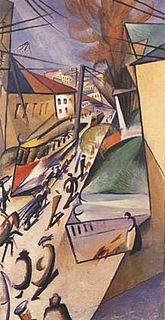
Ukrainian avant-garde is a term widely used to refer the most innovative metamorphosises in Ukrainian art from the end of 1890s to the middle of the 1930s along with associated artists. Broadly speaking, it is Ukrainian art synchronized with the international avant-garde in sculpture, painting, literature, cinema, theater, stage design, graphics, music, architecture. Some Ukrainian avant-garde artists who are fairly well-known include Kazimir Malevich, Alexander Archipenko, Vladimir Tatlin, Sonia Delaunay, Vasyl Yermylov, Alexander Bogomazov, Aleksandra Ekster, David Burliuk, Vadym Meller, Anatol Petrytsky all of them were closely connected to Ukrainian cities Kyiv, Kharkiv, Lviv, Odessa by birth, education, language, national traditions or identity. One of the earliest uses of the term "Ukrainian Avant-Garde" concerning painting and sculpture during Soviet censorship was in the artistic discussion at Tatlin's dream exhibition, curated by Parisian art historian Andréi Nakov, in London, 1973, which showcased works of Ukrainian artists Vasyl Yermylov and Alexander Bogomazov. The first international avant-garde exhibitions in Ukraine which included French, Italian, Ukrainian and Russian artists took place in Odessa and Kyiv at the Izdebsky Salon; later the pieces were shown in St. Petersburg and Riga. The cover of "Izdebsky Salon 2" (1910–11) contained abstract work by Wassily Kandinsky.

Mykhaylo Vasyliovich Semenko was a Ukrainian poet, and a prominent representative of Ukrainian futurist poetry of the 1920s. He is considered to be one of the lead figures of the Executed Renaissance.

An Englishman in Moscow, is a 1914 oil on canvas painting by Russian avant-garde artist and art theorist Kazimir Malevich.
Nova Generatsiia, meaning "New Generation" in English, was a Ukrainian futurist magazine. The magazine was edited by Mikhail Semenko (uk) and was published between October 1927 and December 1930 in Kharkiv. The magazine was the official organ of a group of Ukrainian futurists also led by Semenko who took their name from the magazine and believed that the end of bourgeois art and a period of destruction were necessary to bring about an age of synthesis and the creation of an altogether new and revolutionary form of art.
References
- ↑ Bury, Stephen (2008). Breaking the rules: the printed face of the European avant garde 1900-1937. British Library. ISBN 978-0712309752.
- ↑ "Drowning in text". Evening Standard. 2007-11-21. Retrieved 2016-05-08.
- ↑ Ilnytzkyj, Oleh S. (1998). Ukrainian Futurism, 1914-1930: A Historical and Critical Study. Harvard University Press. ISBN 9780916458591.
- ↑ Greene, Roland; Cushman, Stephen; Cavanagh, Clare; Ramazani, Jahan; Rouzer, Paul; Feinsod, Harris; Marno, David; Slessarev, Alexandra (26 August 2012). The Princeton Encyclopedia of Poetry and Poetics. ISBN 9780691154916.
- 1 2 3 4 5 6 7 Dmitrieva, Marina (2011). Zwischen Stadt und Steppe: künstlerische Texte der ukrainischen Moderne aus den 1910er bis 1930er Jahren. Lukas Verlag. ISBN 9783867321198.